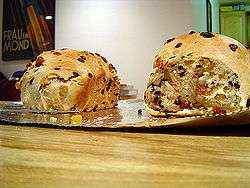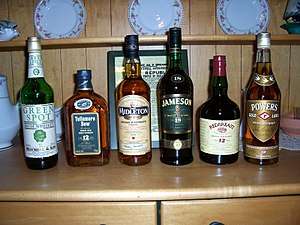Irish cuisine
Irish cuisine is the style of cooking that originated from Ireland, or was developed by the Irish people. It has evolved from centuries of social and political change, and the mixing of the different cultures in Ireland, predominantly the English and Irish (and, in Ulster, the Scottish). The cuisine is founded upon the crops and animals farmed in its temperate climate.
The development of Irish cuisine was altered greatly by the English conquest of the early 17th century, which introduced a new agro-alimentary system of intensive grain based agriculture. Large areas of land were turned over to cereal and a large portion of the population were confined to more marginal agricultural areas. The rise of a commercial market in grain and meat altered the diet of the native population by redirecting these products abroad as cash crops used to feed the British Empire's armed forces and cities.[1] Consequently, the potato, after its widespread adoption in the 18th century, became just about the only food the poor could afford (which was the vast majority of the population). As a result, the potato is often associated with Ireland and "Irish potato" has come to mean any dense, white potato with a low starch content. Many elements of Irish cuisine were lost or abandoned during that time, with the loss being particularly acute between the Great Famine of the mid 19th century and the mid 20th century.
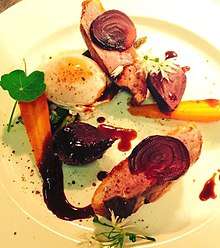
By the 21st century, much of Irish cuisine was being revived. Representative traditional Irish dishes include Irish stew (made with lamb, mutton, or goat), bacon and cabbage (with potatoes), boxty (potato pancake), coddle (sausage, bacon, and potato), colcannon (mashed potato, kale or cabbage, and butter), and, in Ulster, the soda farl. Modern Irish Food still uses these traditional ingredients but they are now being cooked by chefs with world influences and are presented in a modern artistic style.[2]
History
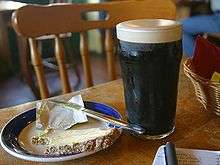
There are many references to food and drink in Irish mythology and early Irish literature, such as the tale of Fionn mac Cumhaill and the Salmon of Knowledge.[3] The old stories also contain many references to banquets involving the heroes' portion and meat cooked in cauldrons and on spits. Irish mythology is a Celtic Indo-European tradition and shares many foods with others in this group. For example, honey has always been valued and was used in the making of mead, a drink featured in many ancient Indo-European myths and rituals, from Ireland to India.
Prehistory
In the Mesolithic period, seafood appears to have played a large part in the diet. Huge mounds of shellfish, known as middens, are common on many parts of the coast. For example, Sligo is a place name meaning "shells", a reference to these mounds. Red deer, wild boar, fish, shellfish, berries, nuts and fruits were the staples of this hunter-gatherer economy.
With the arrival of Neolithic groups, emmer wheat, einkorn and barley began to be grown. Sheep, cattle and goats were kept for their meat, milk and skins.
The most common sites associated with cooking are fulacht fiadh, a name which means a site for cooking deer, consisting of holes in the ground which were filled with water. The water was heated by the introduction of hot stones. There are thousands of fulacht fiadh sites across the island of Ireland and they mostly seem to date from the Bronze Age (1800-900 BC), although many appear to have been used much more recently. Horses arrived in the Bronze Age and seem always to have been taboo as a foodstuff, just like they are in neighbouring Britain.
Gaelic Ireland
Customs and equipment
Hospitality was compulsory on all householders under Irish law and those entitled could sue on refusal. Much evidence for early Irish food exists in the law texts and poetry which were written down from the 7th and 8th century AD onwards. The arrival of Christianity also brought new influences from the Middle east and Roman culture.
The main meal was eaten in the afternoon or evening. A daytime meal was termed díthat. A meal at night, and especially a celebratory one, was called a feis and was often accompanied by beer. Food was served on wooden boards or low tables termed a mias (from mensa, a table, in Latin). Only a knife was used to cut food which was eaten with the hand and using bread. The taste even among very high status individuals seems to have been towards simply prepared dishes, without many spices but with a variety of seasonal accompaniments.The main cooking utensil was the cauldron in which a variety of broths and stews were made. Meals consisted of a staple of bread, fresh milk, or a fermented variety such as bainne clabhair, yoghurt or cheese accompanied by an anlann or tarsunn (relish, condiment) usually of vegetables, salted meat or honey, but could be any variety of seasonal foods. At the public guesthouses (bruiden) a person of high rank was entitled to 3 tarsunn, a lesser person only one.
Grains
Until the arrival of the potato in the 16th century, grains such as oats, wheat and barley, cooked either as porridge or bread, formed the staple of the Irish diet. The most common form of bread consisted of flatbread made from ground oats. These flatbreads could be wafer thin, like chapati, or thicker like the oatcakes still popular in Scotland. Household equipment included a kneading trough lasat, a kneading slab lecc, a griddle lann and a griddle turner lainnéne. While oats were the most commonly used grain, bread made from wheat was regarded as a luxury of the aristocratic class. Bread and milk formed the staple of the Irish diet for millennia. From Latin came tortine meaning a small loaf.
Four varieties of porridge are described in old texts as appropriate for various social classes. Traditional porridge was cooked from oats, barley or wheat meal mixed with water, buttermilk or new milk and cooked to a smooth consistency. This was accompanied by either heavily salted butter, fresh butter or honey.
A fermented mixture of cracked wheat and heated milk was prepared as some form of frumenty or product similar to Turkish tarhana or middle eastern kashk.[4] This could have other ingredients added such as egg yolks making a highly nutritious food that could also be dried and stored over winter.
Another grain preparation known as menedach was made by kneading grains and butter together into a type of paste and was known for its medicinal qualities, especially for monks on strict penitential diets. It may have been an early form of roux or perhaps a type of polenta. It could be spread on bread. It is described in the 12th century Icelandic saga Landnamabok in which Irish slaves prepare the food claiming that it will cure thirst. "The Irish thralls found the expedient of kneading meal and butter and said it would quench the thirst. They called it minapak".
Meat
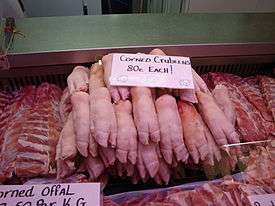
Meat was generally cooked fresh and unspiced, or salted and was boiled in a cauldron (coire). Sometimes it was flavoured with honey. There are many descriptions of meat boiled in a cauldron in a form of stew. One recipe appears to have used "purple berries" to colour the meal. There are also descriptions of meat being parboiled and then roasted over a fire on wooden spits somewhat similar to shish kebab.
Consumption of meat was forbidden twice a week on Wednesday and Friday and during Lent. Céadaoin, the name for Wednesday in Irish, means first fast and Aoine the name for Friday, means fast. Orthodox Christian churches still maintain this practice.
Deer were hunted for meat, being trapped in pits or hunted with dogs.
Both domestic pig and wild boar were eaten. Pork was probably the most common meat consumed in Ireland. Pigs were fattened on acorns in the forests. The flitch of bacon suspended on a hook is frequently mentioned in sources. Sausages made of salted pork are mentioned.Two types of sausage known as maróc (from a Norse loanword) and indrechtán (a sausage or pudding) are mentioned.
The dominant feature of the rural economy was the herding of cattle. Cows were not generally slaughtered for meat unless old or injured, but male cattle, if not destined to be oxen, were often slaughtered at one or two years. Salted beef was cooked in a cauldron where different forms of stew were commonly made. Meat was also barbecued on spits (bir) made of either wood or iron. The poem Aislinge Meic Con Glinne describes the roasting of pieces of beef, mutton and ham on spits of whitebeam. The meat was marinated in salt and honey first. In the Irish religious diet, crane meat is forbidden.
Offal was used in various dishes, with tripe being mentioned the most.
Fish was also sometimes grilled on a spit or griddle over a fire.
The meat of horses and the crane was taboo and avoided. Fowl in general does not seem to have featured much in the diet. There is also evidence for taboos related to totem animals amongst certain groups or tribes for whom consumption of these animals was forbidden.
Dairy
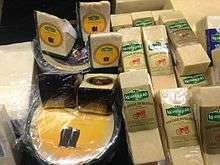
Ireland, with grass growth ten months of the year and no need to shelter cattle in extreme winter conditions, has always produced quality dairy products. Dairy was an important part of the ancient Irish diet, and this is backed up by archaeological record.[5]
Dairy products were known as bánbia (white foods) and milk, butter, curds, and cheese were staples of the diet. Táth was a form of pressed curds, perhaps similar to paneer or cottage cheese. Tánach referred to hard cheese, and mulchán was skimmed milk cheese.
Milk was heated with butter to make a sweet drink called milseán. Milk diluted with water was termed englas.
The practice of bleeding cattle and mixing the blood with milk and butter (similar to the practice of the Maasai people) was not uncommon. Black pudding is made from blood, grain, (usually barley) and seasoning, and remains a breakfast staple in Ireland. [6]
Honey seems to have been a precious commodity, with beekeeping particularly associated with the church and much used in medicine.
Bog butter was allowed to ferment and was buried in bogs to provide a stable temperature during the aging process. The end product may have been something similar to smen, a North African ingredient in many dishes.
Fruit and vegetables
Due to the extensive periods of fasting and the natural shortage of meat and dairy in the early spring, Irish cuisine made extensive use of vegetarian meals.
Vegetables included onions, chives, cabbage, celery, wild garlic and leeks. Fat-hen (Chenopodium album) is often found on pre Norman archaeological sites and appears to have been an important part of the diet, as it still is in Northern India. Skirret (Sium sisaram), in Irish cearrachán, appears to have been grown as a root vegetable, but this is no longer used. Watercress, sorrel, parsley, and nettles were picked wild and eaten raw or added to broth.
Apples and plums seem to have been the most common cultivated fruits.
Pulses such as peas, broad beans, and lentils were grown and dried since early medieval times, providing valuable sources of protein when meat was unavailable.
Berries and nuts were extensively eaten. Hazelnuts were of great importance. Bilberries, known as fraochán in Irish, were traditionally picked on the festival of Lúghnasa in August. Sloes, mulberries and blackberries were also available.
Pepper has been known in Ireland since early Christian times, being an import from the Roman empire.
The fruit of the strawberry tree (Arbutus unedo), known as caithne in Irish, is associated with religious establishments and may have been used to make or flavour medicine.
Drinks
A four-handled wooden cup called a meadair was used, or a drinking horn for high status individuals.
Fermented milk is an Irish drink.
Beer was a prerequisite of a nobles house and was usually brewed from barley, although a wheat beer was also made. Malting kilns are a very common find in archaeological digs in Ireland and appear from early Christian times on.
Uisce beatha (water of life) or whisky is an invention of the Gaelic world and was developed after the introduction of distilling in the 12th century.
Religious diets
Vegetarian diets were known among the strict monastic orders, but it was not compulsory. However, those that did eat meat were only permitted to eat wild pig or deer. Monks lived on a staple gruel made with water or milk and meal known as brothchán. This, on Sundays and festivals had seasonal fruits and nuts and honey added, and it has been suggested that brothchán may have been an early form of muesli.[4]
The Pale
The Pale was the small area around Dublin in which English influence was strongest, here a hybrid food culture developed consisting of Norse, English and Irish influences.
Excavations at the Viking settlement in the Wood Quay area of Dublin have produced a significant amount of information on the diet of the inhabitants of the town. The main meats eaten were beef, mutton, and pork. Domestic poultry and geese as well as fish and shellfish were also common, as was a wide range of native berries and nuts, especially hazel. The seeds of knotgrass and goosefoot were widely present and may have been used to make a porridge.
The Norse word for bean was borrowed into Gaelic as ponaire.
Ovens for baking were used in the towns.
Evidence for cherries has been found in 11th century Dublin. Bread was sometimes flavoured with aniseed.
The Normans
The Norman invasion brought new additions to the diet, introducing rabbits, fallow deer and pheasants in the 12th century. They may also have introduced some freshwater fish, notably pike.
The Norman invasion marked the beginning of both the English and French presence in the country which continued as a unique Hiberno-Norman culture developed in the Norman settled areas and towns. The Norman cuisine characteristically consisted of spicy meat and fowl along with potages and broths, roasts and sauces. The Normans may also have introduced the making of cider. Oysters and scallops were another favourite of the Normans.
Medieval Ireland to Victorian Ireland
Two widely divergent diets developed in Ireland in latter centuries, with stark differences between rich and poor. The rich dined on an abundance of meat such as turkey with beef, roast goose with roasted bacon, cheese, and butter. Game birds such as snipe and pheasant were regularly eaten. Sweets included apple tarts. The cuisine combined that of the developing imperial world, for example curries, alongside Irish staples such as soda bread and potatoes. A 19th century recipe book lists "sweet and savoury puddings of both a baked and boiled variety are the most numerous recipes, followed by recipes for preserved fruits, meat, fish and oysters".[7]
The situation was very different for the poor, who made up 75 percent of the population of around nine million by 1840. Potatoes formed the basis of many Irish dishes and were eaten both by the Anglo-Irish gentry and the mass of the people. This was unusual as the potato was shunned in most of Europe for centuries after its introduction, particularly by the elites. The potato was first introduced into Ireland in the second half of the 16th century, initially as a garden crop. It eventually came to be the main food crop of the poor. As a food source, the potato is extremely valuable in terms of the amount of energy produced per unit area of crop. The potato is also a good source of many vitamins and minerals, particularly vitamin C when fresh. Potatoes were widely cultivated, but in particular by those at a subsistence level. The diet of this group in this period consisted mainly of potatoes supplemented with buttermilk.
At this time Ireland produced large quantities of salted (corned) beef, almost all of it for export . The beef was packed into barrels to provision the British Navy, army, and merchant fleet. Corned beef became associated with the Irish in America where it was plentiful and used as a replacement for the bacon in bacon and cabbage. However, it was not traditional fare in Ireland.
Fresh meat was generally considered a luxury except for the most affluent until the late-19th century. A pig was often kept for bacon and was known as the "gentleman that pays the rent". Potatoes were also fed to pigs, to fatten them prior to their slaughter at the approach of the cold winter months. Much of the slaughtered pork would have been cured to provide ham and bacon that could be stored over the winter. Chickens were not raised on a large scale until the emergence of town grocers in the 1880s allowed people to exchange surplus goods, like eggs, and for the first time purchase a variety food items to diversify their diet.
The over reliance on potatoes as a staple crop meant that the people of Ireland were vulnerable to poor potato harvests. The first Great Famine of 1739 was the result of extreme cold weather, but the famine of 1845–1849 (see Great Irish Famine) was caused by potato blight which spread throughout the Irish crop which consisted largely of a single variety, the Lumper. During the famine approximately one million people died and a million more emigrated.[8]
Tea was introduced during Ireland's time as part of the United Kingdom and became increasingly popular, especially during the 19th century. Irish people are now amongst the highest per capita tea drinkers in the world. Tea is drunk hot and with milk at all times of the day. Slightly stronger varieties are preferred than in England.
Potato Famine
In 1845, the Potato Famine (otherwise known as the Great Famine) began when many potato crops in Ireland had been infected with a mold called Potato Blight. This had turned their potatoes diseased and useless, putting many who are already in poverty into deeper poverty . The crop had failed due to potato blight in 1845-46, had little success in 1847, and failed once again in 1848. The starving Irish tried eating the potatoes, and would get extremely sick from eating them. Irish people began eating a diet of eggs, birds, and plants like nettles and chickweeds.[9] Many Farmers would bleed their cattle out and fry the blood, rather than eat their meat. If the cattle were as malnourished as the people, then the resulting meat wouldn't be fit for consumption, so they resorted to using the blood mixed with herbs, garlic, oats and butter, it could be used as good emergency meal.[10] The extremely desperate and malnourished ate rats and worms found off the street.
Post-Migration
After the Famine, many Irish women migrated to America to escape poverty. With this migration to America, Irish food changed once women began to work in domestic service. Irish women were then exposed to new ingredients and foods not common in Ireland, such as a greater variety of meats and produce.[11] Irish women in domestic service in America had to adapt their cooking to please the upper class in America. This was problematic at first due to Irish women clinging to foods and ingredients common in Ireland. This caused much prejudice towards Irish women and many would mock the Irish’s lack of cooking skills without considering the famine and poverty Irish women grew up with . Newspapers, including the Women’s Journal, published articles encouraging prejudice towards Irish women not knowing how to cook. [12] In time, Irish women in domestic service gained the experience with ingredients abundant in America and altered Irish cuisine to be foods for pleasure. In Ireland food was designed based on caloric intake, instead of for pleasure, such as foods in America. [13] Traditional Irish dishes started to include more meat and fruit and allowed for Irish food to stray from the stigma of being bland .
Modern era
| Life in Ireland |
|---|
| Culture |
| Economy |
| General |
| Society |
| Politics |
| Policies |
In the 21st century, the usual modern selection of foods common to Western culture has been adopted in Ireland. Common meals include pizza, curry, Chinese food, Thai food, and lately, some West African dishes and East European (especially Polish) dishes have been making an appearance, as ingredients for these and other cuisines have become more widely available.
In tandem with these developments, the last quarter of the 20th century saw the emergence of a new Irish cuisine based on traditional ingredients handled in new ways. This cuisine is based on fresh vegetables, fish (especially salmon and trout), oysters, mussels and other shellfish, traditional soda bread, the wide range of cheeses that are now being made across the country, and, of course, the potato. Traditional dishes, such as Irish stew, coddle, the Irish breakfast, and potato bread have enjoyed a resurgence in popularity. Chef and food writer Myrtle Allen - an early protagonist of such attitudes and methods - went on to play a crucial role in their development and promotion.[14] Schools like the Ballymaloe Cookery School have emerged to cater for the associated increased interest in cooking.
Fish and chips take-away is popular. The first fish and chips were sold in Dublin in the 1880s by an Italian immigrant from San Donato Val di Comino, Giuseppe Cervi. His wife Palma would ask customers "Uno di questa, uno di quella?" This phrase (meaning 'one of this, one of the other') entered the vernacular in Dublin as "one and one", which is still a common way of referring to fish and chips in the city.[15]
In much of Ulster (especially Northern Ireland and County Donegal), fish and chips are usually known as a "fish supper". The restaurant from which the food is purchased and the food itself is often referred to as a "chippy" throughout many northern regions of the country.
The proliferation of fast food has led to increasing public health problems, including obesity, where it was reported that as many as 327,000 Irish children are now obese or overweight and in response the Irish Government is now considering introducing a fast food tax.[16] Government efforts to combat obesity have also included television advertising campaigns and educational programmes in schools.[17]
Common foods
- Dairy: butter, milk, buttermilk, cheese[18]
- Grains: barley, oats, wheat
- Freshwater fish: trout, salmon (frequently smoked)
- Meat: beef, chicken, goose, lamb, mutton, pork, offal
- Seafood: mackerel, cod, shellfish (particularly mussels, oysters and lobster)
- Vegetables: cabbage, curly kale, potatoes, carrots, onions, rhubarb
- Fruits: apple, pear, plum, blackberry, strawberry, raspberry, tomatoes
Traditional foods
Breads
- Bairín Breac – a kind of currant cake which contains a golden ring. Traditionally eaten around Halloween.
- Blaa
- Goody – a dessert dish
- Oatcake
- Potato bread
- Soda bread – a popular yeast-free bread
- Soda farl - a traditional food in Ulster, especially in East Donegal, Inishowen and Northern Ireland
- Veda bread
- Wheaten bread
Pork dishes
- Bacon and cabbage
- Black pudding – a traditional dish made from pig's blood, barley and seasoning
- Coddle – main ingredients: pork sausage, back bacon and potato
- Crubeens – pig's trotters
- Skirts and kidneys – a kind of pork stew
Potato dishes
_(2).jpg)
- Boxty – a kind of potato pancake
- Champ – main ingredients: mashed potato, scallions, butter and milk
- Colcannon – main ingredients: mashed potato, kale or cabbage, and butter
- Shepherd's Pie/Cottage Pie – main ingredients: mashed potato, minced lamb/beef, and vegetables[19][20]
Seafood
The consumption of seafood, despite Ireland's enormous coastline, is not as common as in other maritime countries.[21] Irish people eat seafood well below the European average.[21] It appears that it may have been more common in the past, but declined markedly in the last few centuries. There may be various reasons for this. Irish-owned shipping was severely restricted under English governance from the late-16th century on. Ireland was traditionally a cattle-based economy and fish was associated with religious fasting. It was the traditional food of fast on Fridays, in common with other Catholic countries. Also, seafood and particularly shellfish became associated with the poor and the shame of colonisation.[22]
Seafood remained an important part of the diet in coastal cities like Galway and Dublin. In Dublin the fish seller is celebrated in the traditional folk song Molly Malone, and in Galway the international Galway Oyster Festival is held every September.[23] An example of a modern Irish shellfish dish is Dublin Lawyer (lobster cooked in whiskey and cream).[24] Salmon and cod are perhaps the two most common types of fish eaten. Carrageen moss and dulse (both types of red algae) are commonly used in Irish seafood dishes.
Seaweed, by contrast, has always been an important part of the Irish diet and remains popular today. Two popular forms are Dillisk (Palmaria palmata) and Carageen moss or Irish moss (Chondrus crispus, Mastocarpus stellatus), also eaten in the Caribbean.
Others
- Drisheen – a kind of black pudding
- Irish breakfast[25][26]
- Irish stew – a kind of lamb and mutton stew
- Porridge
Traditional beverages
Alcoholic
- Whiskey (particularly pure pot still whiskey) such as Jameson Irish Whiskey, Paddy Whiskey and Bushmills
- Porter or stout such as Guinness, Murphy's Irish Stout and Beamish stout
- Irish red ale such as Smithwick's
- Lager such as Harp Lager
- Irish coffee – made with black coffee, whiskey and whipped cream
- Irish cream such as Baileys
- Irish Mist
- Mead
- Poitín – a very strong (often homemade) spirit made from potatoes or barley.
- Cider, such as Magner's / Bulmer's
Non-alcoholic
Irish chefs
See also
Notes
- ↑ POUSSOU, Jean-Pierre (14 March 2015). "Changing eating habits in Ireland and the Scottish Highlands". Mémoire(s), identité(s), marginalité(s) dans le monde occidental contemporain (12). doi:10.4000/mimmoc.1733.
- ↑ "Modern Irish Food from Ireland". Pinterest. Retrieved 2017-11-18.
- ↑ "The Salmon of Knowledge. Celtic Mythology, Fairy Tale". Luminarium.org. Retrieved 12 December 2017.
- 1 2 Monk, Michael A.; Sheehan, John (1998-01-01). Early Medieval Munster: Archaeology, History and Society. Cork University Press. ISBN 9781859181072.
- ↑ "Meat and Dairy Products". Askaboutireland.ie. Retrieved 12 December 2017.
- ↑ "A History of Irish Cuisine". www.ravensgard.org.
- ↑ "Cork wealthy dined on "turtle soup and champagne" during Ireland's Great Hunger". IrishCentral.com. Retrieved 2016-03-18.
- ↑ Ross, David (2002), Ireland: History of a Nation, New Lanark: Geddes & Grosset, p. 226, ISBN 1-84205-164-4
- ↑ "Common Myths About The Great Irish Potato Famine - CulinaryLore.com". www.culinarylore.com. Retrieved 2018-04-05.
- ↑ T., Lucas, A. (1989). Cattle in ancient Ireland. Kilkenny, Ireland: Boethius Press. ISBN 0863141455. OCLC 18623799.
- ↑ Lynch-Brennan, Margaret (2009). The Irish Bridget: Irish Immigrant Women in Domestic Service in America, 1840-1930.
- ↑ Lynch-Brennan, Margaret (2009). The Irish Bridget: Irish Immigrant Women in Domestic Service in America, 1840-1930.
- ↑ Diner, Hasia (1991). Hungering for America: Italian, Irish, and Jewish Foodways in the Age of Migration.
- ↑ Andrews, Coleman. "Heart and Hearth". Saveur Magazine. Retrieved 11 May 2014.
- ↑ Hegarty, Shane (3 November 2009). "How fish and chips enriched a nation". The Irish Times. Dublin. p. 17.
- ↑ "Taxing ourselves thin – the way forward?". Irish Health. Retrieved 6 February 2012.
- ↑ "Govt plans to tackle childhood obesity". RTÉ. 9 November 2011. Archived from the original on 18 January 2012. Retrieved 6 February 2012.
- ↑ Davenport 2008, p. 66
- ↑ Dewdropdeb (5 May 2008). "Traditional Irish Shepherd's Pie". Recipes. Food.com. Retrieved 13 May 2012.
- ↑ Christina Finn (17 March 2012). "Top Ten Recipes for St Patrick's Day- A list of Irish Mammy dinners have been summed up by Irish Central listing corned beef and shepherd's pie among the staples of the Irish diet". Ireland's best bits – stuff the world thinks we're great at. TheJournal.ie. Retrieved 13 May 2012.
- 1 2 "Why do Irish people not eat more fish?". Irish Times. Retrieved 21 June 2017.
- ↑ Archived 10 March 2016 at the Wayback Machine.
- ↑ "galwayoysterfest.com". Galwayoysterfest.com. Retrieved 12 December 2017.
- ↑ "Dublin Lawyer". Irelandseye.com. Retrieved 12 December 2017.
- ↑ "Today Show Irish Breakfast". MSNBC. 17 March 2009. Retrieved 21 September 2010.
- ↑ "Irish Breakfast at". Foodireland.com. Retrieved 21 September 2010.
References
Further reading
- Broadway, Michael. "Implementing the Slow Life in Southwest Ireland: A Case Study of Clonakilty and Local Food." Geographical Review 105.2 (2015): 216-234.
- Danaher, Pauline. "From Escoffier to Adria: Tracking Culinary Textbooks at the Dublin Institute of Technology 1941–2013." M/C Journal 16.3 (2013).
- Lucas, Anthony T. "Irish food before the potato." Gwerin: A Half-Yearly Journal of Folk Life 3.2 (1960): 8-43.
- Mac Con Iomaire, M. (2004) "The history of seafood in Irish cuisine and culture,'" History Studies, Vol. 5, University of Limerick pp. 61–76. (http://arrow.dit.ie/tfschafart/106)
- Mac Con Iomaire, M. (2008) "Searching for Chefs, Waiters and Restaurateurs in Edwardian Dublin: A Culinary Historian’s Experience of the 1911 Dublin Census Online" in Petits Propos Culinaires 86. pp. 92–126. (http://arrow.dit.ie/tfschafart/1/)
- Mac Con Iomaire, M. and P. Gallagher (2009) "The Potato in Irish Cuisine and Culture" in Journal of Culinary Science and Technology Vol. 7, Issues 2-3, pp. 1–16 (http://arrow.dit.ie/tfschafart/3/)
- Mac Con Iomaire, M. (2010) "The Pig in Irish Cuisine and Culture" in MC Journal – the Journal of Media and Culture, Vol. 13, No. 5. (http://arrow.dit.ie/tfschafart/2/)
- Mac Con Iomaire,M. (2010) "Irish Corned Beef: A Culinary History" in Journal of Culinary Science and Technology, Vol. 9, No. 2. (http://arrow.dit.ie/tfschafart/23/)
- Mac Con Iomaire, M. (2011) "The Changing Geography and Fortunes of Dublin’s Haute Cuisine Restaurants 1958-2008," in Food, Culture & Society: An International Journal of Multidisciplinary Research, Vol. 14, No. 4. pp. 525–545. (http://arrow.dit.ie/tfschafart/112/)
- Mac Con Iomaire, M. (2012) "Coffee Culture in Dublin: A Brief History." in M/C Journal - A Journal of Media and Culture. Vol. 15, No. 2. -'coffee'.[1][2]
- Mac Con Iomaire, Máirtín. (2013) "Public dining in Dublin: The history and evolution of gastronomy and commercial dining 1700-1900." International Journal of Contemporary Hospitality Management 25.2 (2013): 227-246.
- Mahon, Bríd. Land of Milk and Honey: The Story of Traditional Irish Food & Drink (Dufour Editions, 1991)
External links

- Wikibooks Cookbook
- ↑ Iomaire, Máirtín Mac Con (2 May 2012). "Coffee Culture in Dublin: A Brief History". M/C Journal. 15 (2). Retrieved 12 December 2017.
- ↑ Máirtín, Mac Con Iomaire, (12 December 2017). "Coffee Culture in Dublin: a Brief History". Retrieved 12 December 2017.
.jpg)
